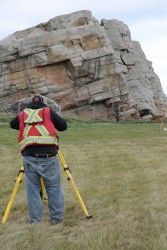Article Origin
Volume
Issue
Year
It may not be readily apparent what the Okotoks Erratic has in common with world heritage sites such as ChichÈn Itz·, the Titantic, the Parthenon and Machu Picchu, but it is one of two Canadian sites that has been selected by the CyArk 500 Challenge, an international project that is digitally preserving vulnerable, culturally significant historic sites around the world.
Located near the town of Okotoks, the seven-million-kilogram boulder is part of a train of glacial erratics that was moved along the east slopes of the Rockies by the Wisconsin Glacier 12,000-17,000 years ago, said Blair First Rider, a Blood Elder with the Historic Resources Management Branch of Alberta Culture and Tourism. First Rider espouses two views of how the glacial erratic arrived at its present location: the Western scientific view and Blackfoot Creation stories.
Of cultural and spiritual significance to the Blackfoot people, ochre pictographs on the immense boulder record a story of origins of the Blackfoot people. The Stoney and Sarcee have some affinity as well, says First Rider.
“The oral history and knowledge that goes with features of the landscape is a way of recording our territory. It is a sacred site to us,” he said. “The pictographs are records of vision quests and offering sites of visitors to the stone.”
Over the past several years, the erratic has been repeatedly vandalized with graffiti, spray paint and felt markers. Constant removing of the graffiti has resulted in removing a layer of rock and fading of the centuries old pictographs.
“There has been erosion because of the elements, not just vandalism,” said Alireza Farrokhi, also with the Historic Resources Management Branch of Alberta Culture and Tourism.
When considering how to approach the problem, several universities were consulted. Ultimately, the provincial government, bringing their own resources, settled on a partnership with CyArk, said Farrokhi, a civil engineer from Iran, who has been working on the project for the past three years.
The erratic is one of two Canadian sites selected for digital preservation by the CyArk 500 challenge, a global initiative launched at a summit in 2013 at the Tower of London. Passionate about the loss, erosion and destruction of heritage sites, the Kacyra family created a non-profit organization to use 3-D technology to preserve sites around the world for posterity.
Sites are chosen by an advisory board and are based on a letter addressing three criteria, said Makenna Murray of the CyArk Challenge, based in Oakland, California, which aims to have 500 projects captured digitally in five years. Sites are chosen for their local, global and international significance, the particular risks that face places at threat of disappearance in 10 years, and a consideration of the particular benefits of each. Fort Conger in Quttinirpaaq National Park on Ellesmere Island is the second Canadian site.
“The 3-D process of preservation begins with 3-D scanner technology, a full 360 degree scan. Then it is brought back to Oakland for data processing,” said Makenna.
Surprisingly, the scanning technology has revealed additional pictographs, not visible to the naked eye, said Alireza.
“It is remarkable technology,” said First Rider, “that does well to preserve, protect and present.”
- 1052 views

